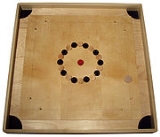
Pitchnut
Encyclopedia
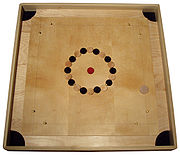
Tabletop game
Tabletop game is a general term used to refer to board games, card games, dice games, miniatures wargames, tile-based games and other games that are normally played on a table or other flat surface...
of French Canadian
French Canadian
French Canadian or Francophone Canadian, , generally refers to the descendents of French colonists who arrived in New France in the 17th and 18th centuries...
origins, similar to carrom
Carrom
Carrom is a family of tabletop games with gameplay that lies somewhere between billiards and table shuffleboard. Carrom is known by many names around the world, including carrum, couronne, carum, karam, karom, karum, fatta and finger billiards...
and pichenotte
Pichenotte
Pichenotte is a French Canadian tabletop game, with a board, game pieces and rules similar to carrom. Used more broadly, the term is a general name for tabletop games played with small pieces that are flicked using the thumb and index finger, including such games as carrom, sharing a similarity...
, with mechanics that lie somewhere between pocket billiards
Pocket billiards
Pool, also more formally known as pocket billiards or pool billiards , is the family of cue sports and games played on a pool table having six receptacles called pockets along the , into which balls are deposited as the main goal of play. Popular versions include eight-ball and nine-ball...
and air hockey
Air hockey
Air hockey is a game for two competing players trying to score points in the opposing player's goal.-Equipment:Air hockey requires an air-hockey table, two player-held mallets, and a puck....
. There are no records of the game being mass-produced. All existing boards are handmade and frequently handed down from generation to generation. The game is common on the farming villages surrounding Trois-Rivières
Trois-Rivières
Trois-Rivières means three rivers in French and may refer to:in Canada*Trois-Rivières, the largest city in the Mauricie region of Quebec, Canada*Circuit Trois-Rivières, a racetrack in Trois-Rivières, Quebec...
and Sherbrooke, Quebec, Canada.
Origins
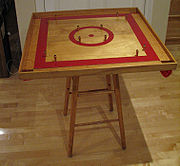
Crokinole
Crokinole is an action board game similar in various ways to pitchnut, carrom, marbles, and shove ha'penny, with elements of shuffleboard and curling reduced to table-top size...
with pichenotte
Pichenotte
Pichenotte is a French Canadian tabletop game, with a board, game pieces and rules similar to carrom. Used more broadly, the term is a general name for tabletop games played with small pieces that are flicked using the thumb and index finger, including such games as carrom, sharing a similarity...
, the French Canadian
French Canadian
French Canadian or Francophone Canadian, , generally refers to the descendents of French colonists who arrived in New France in the 17th and 18th centuries...
version of carrom
Carrom
Carrom is a family of tabletop games with gameplay that lies somewhere between billiards and table shuffleboard. Carrom is known by many names around the world, including carrum, couronne, carum, karam, karom, karum, fatta and finger billiards...
. A similar board was patented in 1893 by E.L. Williams, but that game board had 8 pegs in the center of the board (like crokinole) but had only one peg in front of each pocket. Wayne Kelly's crokinole.com web site shows an image of a board that looks very similar to pitchnut, but the pegs in front of the pockets take the form of a wicket
Wicket
In the sport of cricket the word wicket has several distinct meanings:-Definitions of wicket:Most of the time, the wicket is one of the two sets of three stumps and two bails at either end of the pitch...
through which the players had to shoot their pieces, according to Mr. Kelly. Pitchnut is primarily played in the farming villages around Three Rivers and Sherbrooke, Quebec. As descendents of those villages moved to small cities and the U.S., the game has spread. The game is usually played around Christmas time.
Equipment
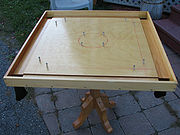
Quebec
Quebec or is a province in east-central Canada. It is the only Canadian province with a predominantly French-speaking population and the only one whose sole official language is French at the provincial level....
, theorizes that the recessed gutters were added to direct playing pieces toward the pockets. In Carrom or pichenotte, a piece that is struck will not be guided towards the pockets. Pitchnut also has 4 pegs (or "screws") in the center of the board and two pegs in front of each pocket. The game is played with small disks (crokinole
Crokinole
Crokinole is an action board game similar in various ways to pitchnut, carrom, marbles, and shove ha'penny, with elements of shuffleboard and curling reduced to table-top size...
pieces or wooden checkers).
The object of the game is to finger-flick a comparatively heavy disk, called a striker, shooter or pitch, such that it contacts lighter object disks and propels them into one of four corner pockets. The pieces come in two sets, usually white and black, denoting the two players (or, in doubles play, teams). An additional piece is colored (red and green are common) and called the "poison", which is the puck equivalent of the eight ball in pool games.
Rules
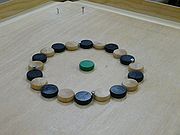
Play begins with alternating ten or eleven differently colore pieces in a ring, in the center of the board. Five or six pieces fit between each peg. A piece of a third colored piece (poison) is placed in the center of the board.

The shooter is usually shot with the index or middle finger and thumb in a flicking action ("pichenette" in French). The shooter may be pushed briefly with a finger, in a shoving motion, without the use of the thumb, but may not be pushed or dragged with the finger ("carried") across the player's home line.
American pitchnut is played with rules that are very similar to 8-ball pool. A player must pocket all of his/her pieces and then the poison. If the poison is sunk before all of a player's pieces are pocketed, that player loses. Games usually last around five minutes.
Canadian pitchnut uses the same rules as pichenotte
Pichenotte
Pichenotte is a French Canadian tabletop game, with a board, game pieces and rules similar to carrom. Used more broadly, the term is a general name for tabletop games played with small pieces that are flicked using the thumb and index finger, including such games as carrom, sharing a similarity...
, a similar game that does not have pegs or recessed gutters. The object is to score 50 points before your opponent does. A player earns five points for each of his opponents pieces that remain on the board. The odd-colored piece (dame) is worth fifteen points and can be shot in at any time (some rules require that a player "cover" the dame by immediately sinking one of his/her own pieces. Some families/regions play with two odd-colored pieces in the center. A game can consist of several rounds of play, and a game can last 20 minutes or more.
External links
- Pitchnut website — with rules, events of the Amherst Regional High School Pitchnut Club, news, gallery
- Alfred University's Pitchnut League

